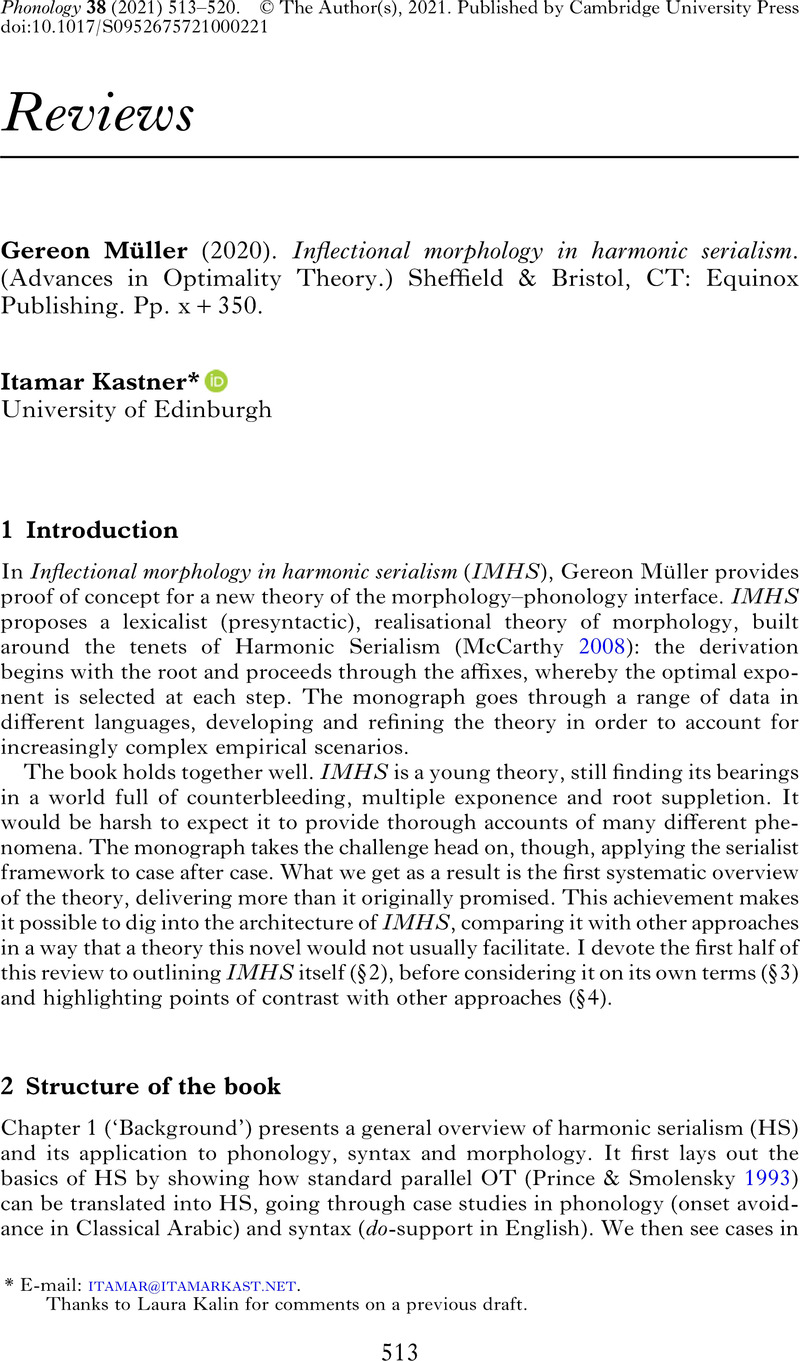No CrossRef data available.
Article contents
Gereon Müller (2020). Inflectional morphology in harmonic serialism. (Advances in Optimality Theory.) Sheffield & Bristol, CT: Equinox Publishing. Pp. x + 350.
Published online by Cambridge University Press: 23 December 2021
Abstract
An abstract is not available for this content so a preview has been provided. Please use the Get access link above for information on how to access this content.

- Type
- Review
- Information
- Copyright
- Copyright © The Author(s), 2021. Published by Cambridge University Press
Footnotes
Thanks to Laura Kalin for comments on a previous draft.
References
Arad, Maya (2003). Locality constraints on the interpretation of roots: the case of Hebrew denominal verbs. NLLT 21. 737–778.Google Scholar
Baker, Mark (1985). The mirror principle and morphosyntactic explanation. LI 16. 373–415.Google Scholar
Bobaljik, Jonathan David (2012). Universals in comparative morphology: suppletion, superlatives, and the structure of words. Cambridge, MA: MIT Press.CrossRefGoogle Scholar
Chomsky, Noam (1973). Conditions on transformations. In Anderson, Stephen R. & Kiparsky, Paul (eds.) A Festschrift for Morris Halle. New York: Holt, Rinehart & Winston. 232–286.Google Scholar
Embick, David (2010). Localism versus globalism in morphology and phonology. Cambridge, MA: MIT Press.CrossRefGoogle Scholar
Kalin, Laura (2020). Infixes really are (underlyingly) prefixes/suffixes: evidence from allomorphy on the fine timing of infixation. Ms, Princeton University. https://ling.auf.net/lingbuzz/005581.Google Scholar
McCarthy, John J. (2007). Hidden generalizations: phonological opacity in Optimality Theory. Sheffield & Bristol, CT: Equinox.Google Scholar
McCarthy, John J. (2008). The serial interaction of stress and syncope. NLLT 26. 499–546.Google Scholar
Manova, Stela, Hammarström, Harald, Kastner, Itamar & Nie, Yining (2020). What is in a morpheme? Theoretical, experimental and computational approaches to the relation of meaning and form in morphology. Word Structure 13. 1–21.CrossRefGoogle Scholar
Moskal, Beata & Smith, Peter W. (2016). Towards a theory without adjacency: hyper-contextual VI-rules. Morphology 26. 295–312.CrossRefGoogle Scholar
Muysken, Pieter (1988). Affix order and interpretation: Quechua. In Everaert, Martin, Evers, Arnold, Huybregts, Rini & Trommelen, Mieke (eds.) Morphology and modularity: in honour of Henk Schultink. Dordrecht: Foris. 259–279.CrossRefGoogle Scholar
Myler, Neil (2017). Exceptions to the Mirror Principle and morphophonological ‘action at a distance’: the role of ‘word’-internal phrasal movement and spell-out. In Newell, Heather, Noonan, Máire, Piggott, Glyne & Travis, Lisa deMena (eds.) The structure of words at the interfaces. Oxford: Oxford University Press. 100–125.Google Scholar
Prince, Alan & Smolensky, Paul (1993). Optimality Theory: constraint interaction in generative grammar. Ms, Rutgers University & University of Colorado, Boulder. Published 2004, Malden, MA & Oxford: Blackwell.Google Scholar
Pross, Tillmann & Roßdeutscher, Antje (2019). Towards a correlation of form, use and meaning of German ge-prefixed predicative participles. Glossa 4(1):93. http://dx.doi.org/10.5334/gjgl.753.CrossRefGoogle Scholar
Rice, Keren (2000). Morpheme order and semantic scope: word formation in the Athapaskan verb. Cambridge: Cambridge University Press.CrossRefGoogle Scholar





